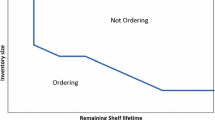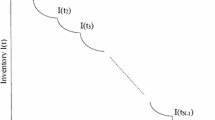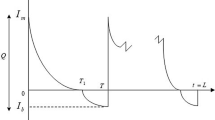Abstract
This study addresses the problem of combined pricing and inventory control in the context of perishable goods—specifically, when demand is uncertain and price-sensitive and the consumers are free to choose between new and old units, based on the relative affordability of prices. First, the problem is formulated as a periodic review problem for a product with finite arbitrary lifetime and a myopic policy, which is often followed in practice, is discussed. Analytically it is shown that the solution obtained by the policy is also the unique solution that maximizes the individual profits from the inventories at each age. Next, this study addresses a special case—that of products with two-period lifetime, which is a scenario of practical importance. It is proven that under the policy of discounts and sticky pricing, which is often practiced in the brick-and-mortar retail stores, the myopic policy is in fact the steady-state optimal policy of the infinite-horizon problem. The study concludes with a numerical example and directions for future research in the area of joint pricing and inventory management of deteriorating, perishable products.



Similar content being viewed by others
References
Abad, P. (1996). Optimal pricing and lot-sizing under conditions of perishability and partial backordering. Management Science, 42(8), 1093–1104.
Abad, P. (2003). Optimal pricing and lot-sizing under conditions of perishability, finite production and partial backordering and lost sale. European Journal of Operational Research, 144(3), 677–685. doi:10.1016/S0377-2217(02)00159-5.
Abad, P. L. (2001). Optimal price and order size for a reseller under partial backordering. Computers and Operations Research, 28(1), 53–65.
Bakker, M., Riezebos, J., & Teunter, R. H. (2012). Review of inventory systems with deterioration since 2001. European Journal of Operational Research, 221(2), 275–284.
Blinder, A. S. (1991). Why are prices sticky? Preliminary results from an interview study. http://www.nber.org/papers/w3646
Burnetas, A. N., & Smith, C. E. (2000). Adaptive ordering and pricing for perishable products. Operations Research, 48(3), 436–443.
Chan, L. M. A., Shen, Z. J. M., Simchi-Levi, D., & Swann, J. L. (2004). Coordination of pricing and inventory decisions: A survey and classification. In D. Simchi-Levi, S. D. Wu, & Z. J. Shen (Eds.), Handbook of quantitative supply chain analysis: Modeling in the e-business era (International series in operations research and management Science, (pp. 335–392).
Chang, H. J., Teng, J. T., Ouyang, L. Y., & Dye, C. Y. (2006). Retailer’s optimal pricing and lot-sizing policies for deteriorating items with partial backlogging. European Journal of Operational Research, 168(1), 51–64. doi:10.1016/j.ejor.2004.05.003.
Chen, L. M., & Sapra, A. (2013). Joint inventory and pricing decisions for perishable products with two-period lifetime. Naval Research Logistics, 60(5), 343–366.
Choi, S. C. (1991). Price competition in a channel structure with a common retailer. Marketing Science, 10(4), 271–296.
Chun, Y. H. (2003). Optimal pricing and ordering policies for perishable commodities. European Journal of Operational Research, 144(1), 68–82.
Dasu, S., & Tong, C. (2010). Dynamic pricing when consumers are strategic: Analysis of posted and contingent pricing schemes. European Journal of Operational Research, 204(3), 662–671. doi:10.1016/j.ejor.2009.11.018.
Dye, C. Y. (2007). Joint pricing and ordering policy for a deteriorating inventory with partial backlogging. Omega, 35(2), 184–189. doi:10.1016/j.omega.2005.05.002.
Dye, C. Y., Hsieh, T. P., & Ouyang, L. Y. (2007). Determining optimal selling price and lot size with a varying rate of deterioration and exponential partial backlogging. European Journal of Operational Research, 181(2), 668–678. doi:10.1016/j.ejor.2006.06.029.
Elmaghraby, W., & Keskinocak, P. (2003). Dynamic pricing in the presence of inventory considerations: Research overview, current practices, and future directions. Management Science, 49(10), 1287–1309.
Fabricant, F. (1999). Food stuff. http://www.nytimes.com/1999/08/18/dining/food-stuff.html. Accessed April 13, 2013.
Ferguson, M. E., & Koenigsberg, O. (2007). How should a firm manage deteriorating inventory? Production and Operations Management, 16(3), 306–321.
Fudenberg, D., & Tirole, J. (1991). Game theory. Cambridge, MA: MIT Press.
Heyman, D. P., & Sobel, M. J. (2004). Stochastic models in operations research-stochastic optimization. Mineola, NY: Dover Publications.
http://boards.straightdope.com (N/A) Do they sell day old bread and cakes in your area? http://boards.straightdope.com/sdmb/showthread.php?p=10125673. Accessed August 13, 2013.
http://chowhound.chow.com (N/A) Why are we wasting so much food? http://chowhound.chow.com/topics/806141. Accessed August 13, 2013.
Karaesmen, I. Z., Scheller-Wolf, A., & Deniz, B. (2011). Managing perishable and aging inventories: Review and future research directions. Planning production and inventories in the extended enterprise (pp. 393–436). New York, NY: Springer.
Kashyap, A. K. (1995). Sticky prices: New evidence from retail catalogs. The Quarterly Journal of Economics, 110(1), 245–274.
Li, Y., Lim, A., & Rodrigues, B. (2009). Pricing and inventory control for a perishable product. Manufacturing and Service Operations Management, 11(3), 538–542.
Maihami, R., & Kamalabadi, I. N. (2012). Joint pricing and inventory control for non-instantaneous deteriorating items with partial backlogging and time and price dependent demand. International Journal of Production Economics, 136(1), 116–122.
Mukhopadhyay, S., Mukherjee, R., & Chaudhuri, K. (2004). Joint pricing and ordering policy for a deteriorating inventory. Computers and Industrial Engineering, 47(4), 339–349. doi:10.1016/j.cie.2004.06.007.
Nahmias, S. (1982). Perishable inventory theory: A review. Operations Research, 30(4), 680–708.
Nahmias, S. (2011). Perishable inventory systems (International series in operations research and management science). New York, NY: Springer.
Petruzzi, N. C., & Dada, M. (1999). Pricing and the newsvendor problem: A review with extensions. Operations Research, 47(2), 183–194.
Phillips, R. L. (2005). Pricing and revenue optimization. Stanford, CA: Stanford University Press.
Porteus, E. L. (2002). Foundations of stochastic inventory theory. Stanford, CA: Stanford University Press.
Rajan, A., Steinberg, R., & Steinberg, R. (1992). Dynamic pricing and ordering decisions by a monopolist. Management Science, 38(2), 240–262.
Schuler, T. (2009). Water, flour, salt, spice The Munich Hofpfisterei bakes bread according to an 2,000-year-old method. http://www.atlantic-times.com/archive_detail.php?recordID=1909. Accessed April 13, 2013.
Singh, N., & Vives, X. (2012). Price and quantity competition in a differentiated duopoly. The RAND Journal of Economics, 15(4), 546–554.
Talluri, K. T., & van Ryzin, G. J. (2005). The theory and practice of revenue management. New York, NY: Springer.
Tirole, J. (1988). The theory of industrial organization. Cambridge, MA: MIT Press.
Wee, H. M., & Law, S. T. (2001). Replenishment and pricing policy for deteriorating items taking into account the time-value of money. International Journal of Production Economics, 71(1), 213–220. doi:10.1016/S0925-5273(00)00121-3.
Zhu, K., & Thonemann, U. W. (2009). Coordination of pricing and inventory control across products. Naval Research Logistics, 56(2), 175–190.
Acknowledgments
The author is thankful to the editorial team and the anonymous referees for their helpful comments. The author also thanks Jishnu Hazra and Amar Sapra for their constructive support and comments on the paper. This work had been partially supported by the EADS-SMI Endowed Chair for Sourcing and Supply Management at IIMB.
Author information
Authors and Affiliations
Corresponding author
Proofs of Lemmas and Theorems
Proofs of Lemmas and Theorems
Proof of Lemma 1
Let \(x = \left\langle p_0^x, p_1^x, \ldots , p_{n-1}^x \right\rangle \) and \(y = \left\langle p_0^y, p_1^y, \ldots , p_{n-1}^y \right\rangle \) be two points in \({\fancyscript{S}}\). Therefore,
Hence, \({\fancyscript{S}}\) is convex. Further, \({\fancyscript{S}}\) is a closed and bounded set. Therefore, \({\fancyscript{S}}\) is compact. Because \({\fancyscript{R}}\) is a closed subset of \({\fancyscript{S}}\), \({\fancyscript{R}}\) is compact. The convexity of \({\fancyscript{R}}\) is proven as follows:
Let \(x = \left\langle p_0^x, p_1^x, \ldots , p_{n-1}^x \right\rangle \) and \(y = \left\langle p_0^y, p_1^y, \ldots , p_{n-1}^y\right\rangle \) be two points in \({\fancyscript{R}}\). Therefore, for each \(i, \xi _i(x) \geqslant 0\) and \(\xi _i(y) \geqslant 0\), which implies \( \lambda \, \xi _i(x) + (1 - \lambda ) \, \xi _i(y) \geqslant 0\) for all \(\lambda \in [0,1]\). Using the definition of \(\xi _i(\cdot )\), it can be shown that \(\lambda \, \xi _i(x) + (1 - \lambda ) \, \xi _i(y) = \xi _i(\lambda \, x + (1-\lambda ) \, y)\). \(\square \)
Proof of Lemma 2
The interior optimizer of (3) satisfies the FOCs with respect to the decision variables.
The FOCs listed above form the necessary conditions for interior optimality. If there is no interior maximizer, then the solution occurs on the boundary of the compact set \({\fancyscript{R}}\). \(\square \)
Proof of Proposition 3
Consider a game of n players wherein each player tries to maximize its payoff. Let player i denote the manager who manages the inventory of class i to maximize his own profit. In such a game, the payoff of the players are:
The second-order conditions of optimality indicate that for all \(1 \leqslant i \leqslant n-1\)
Petruzzi and Dada (1999) prove the unimodality of \(\Pi _0(p_0)\) under the (technical) Assumption V. Hence, by Theorem 1.2 of Fudenberg and Tirole (1991), there exists a unique pure-strategy Nash equilibrium in the convex compact set \({\fancyscript{R}}\). Thus, the solution to the simultaneous Eq. (4) is the unique solution that maximizes the profits from inventory of each class (or age). \(\square \)
Proof of Proposition 1
According to Assumption II, whenever \(p_0 = p_1 = p \geqslant 0 \), it is required that \(\tilde{a}_1 - b_1 p_1 + c_1 p_0 = 0\). The boundary condition \(p = 0\) indicates that \(\tilde{a}_1 = 0\). Hence, for non-zero values of p, it is true that \((b_1 - c_1) p = 0 \Rightarrow b_1 = c_1\). Therefore, using Assumption I, it can be established that \(b_0 > c_{10} = b_1 > c_{01} > 0\).\(\square \)
Proof of Theorem 1
For each period, the state of the system is the initial on-hand inventory (x); the set of states is \({\mathcal {S}}= {\mathbb {R}}_{\geqslant 0}\); the action is the quantity of new units to be ordered (\(y\)); and the action set for each state \( x \in {\mathcal {S}}\) is \( A_x = {\mathbb {R}}_{\geqslant 0}\). The state-action space is \({\fancyscript{C}}\,\triangleq \,\lbrace (x,y): x \in {\mathcal {S}}, y \in A_s \rbrace \). Let \(S(y)\,\triangleq \,\lbrace x : y \in A_x, x \in {\mathcal {S}} \rbrace \) be the set of states where action y is feasible.
The profit function defined in (1) satisfies the nine sufficient conditions listed in Heyman and Sobel (2004) and Porteus (2002), for existence of optimal myopic policy, as shown below. Condition I: Expected single-stage profit depends additively on the state x and action y: For a given price vector \((p_0,p_1)\), \(J(y,p_0,p_1) = K(y) + L(x) \, \forall (x,y) \in {\fancyscript{C}}\) where \(K(y) = (p_0 - c)y - p_0 E [y - \xi _0]^+\) and \(L(x) = p_1 x - p_1 E[x - \xi _1]^+\).
Condition II: The future state depends only on the current action: The on-hand inventory at the start of period \(t+1\) depends on the action taken in t as \(x^{t+1} = [y^t - \xi _0^t]^+\). Therefore, \(\forall \, y \in A, \; \exists \; \omega (y) = [y-\xi _0]^+ : x_{n+1} = [y_n-\xi _0^n]^+ = \omega (y_n)\). Therefore, \(x_{n+1} \sim \omega (y_n)\).
Condition III: Let \(\gamma (y) \triangleq K(y) + \beta E\lbrace L[\omega (y)] \rbrace ,\, y \in A\). A maximizer \(y^*\) of \(\gamma \) exists:
Note that
is convex in y and hence, so is its expected value. Since, \(\gamma (y)\) is concave in y, there exists a unique constrained maximizer, \(y^*\) subject to the constraint \( y \geqslant 0\). That is \(y^* = \hbox {argmax}_{y \geqslant 0} \gamma (y)\).
Condition IV: \(y^*\) defined in Condition III is feasible in every period with probability 1: The action set for every state \(x\) is \(A_x = {\mathbb {R}}_{\geqslant 0}\). So, since \(y^* \geqslant 0 \), it is feasible for any state x. Therefore, \(P \lbrace \omega (y^*) \in S(y^*) \rbrace = 1\).
Condition V: For every \(x \in {\mathcal {S}}\) there is \(b_x \in A_x\) such that \(\gamma (b_x) \geqslant \gamma (y) \,\, \forall \,\, y \in A_x\) : Since \(x \in S(y^*) \; \forall \; x \in {\mathcal {S}}\), the constrained maximizer \(y^*\) is \(b_x\) and \(\gamma (b_x) = \gamma (y^*) \geqslant \gamma (y) \, \forall \, y \in A_x \) and \(\forall \, x \in {\mathcal {S}}\), without loss of optimality.
Condition VI: \(\gamma (\cdot )\) is non increasing on \([y^*,\infty )\): This is true since \(\gamma (\cdot )\) is concave.
Condition VII: If y and \(y'\) are such that \(y^* \leqslant y \leqslant y'\), then \(P \lbrace \omega (y) \leqslant \omega (y') \rbrace = 1\): Let \(\delta = y' - y \geqslant 0 \). By definition \(\omega (y) = [y-\xi _0]^+\) and \( \omega (y') = [y'-\xi _0]^+ = [y + \delta -\xi _0]^+\). So,
Condition VIII: There is a nondecreasing function \(M(\cdot )\) such that \(M(x) = \min \lbrace y : y \in A_x \rbrace \,\, \forall \, x \not \in S(y^*)\) : Because there does not exist a state x at which the action \(y^*\) is not feasible, any definition of \(M(\cdot )\) vacuously adheres to the definition mentioned above. Without loss of generality, the function \(M(x)\) can be defined as the constant function \(M(x) = 0\).
Condition IX: If \(x \not \in S(y^*)\) and \(y \in A_x\), then \(y > y^*\): This condition holds true vacuously.
Since, for a given price vector \((p_0,p_1)\), the sufficient conditions I through IX are satisfied for the profit function, there exists a optimal myopic ordering policy for new units. \(\square \)
Proof of Lemma 4
Let \(X_0\) and \(X_1\) be two positive random variables, and let the positive random variable \(Z\) be defined as \(Z = \left[ [K_0-X_0]^+ - K_1 - X_1\right] ^+\) where \(K_0\) and \(K_1\) are positive real numbers. The expected value of \(Z\) can be obtained as below:
\(Z = \left[ [y - D_0 - \epsilon _0]^+ -D_1 - \epsilon _1 \right] ^+\) when \(K_0 = y - D_0\) and \(K_1 = D_1\), and \(P(Z>z) = \int _0^{u-z} F_0(u-z-x_1) f_1(x_1) dx_1\). The, expected value of Z is:
\(\square \)
Rights and permissions
About this article
Cite this article
Chintapalli, P. Simultaneous pricing and inventory management of deteriorating perishable products. Ann Oper Res 229, 287–301 (2015). https://doi.org/10.1007/s10479-014-1753-9
Published:
Issue Date:
DOI: https://doi.org/10.1007/s10479-014-1753-9




